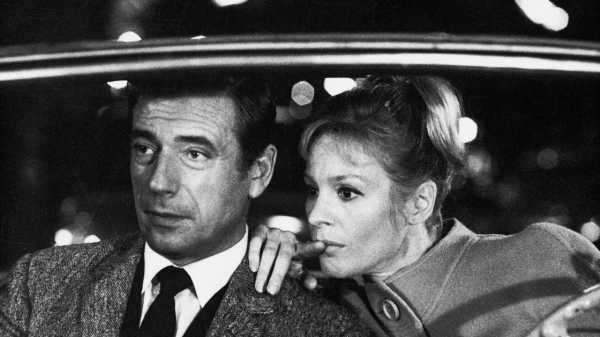
Alain Resnais, whose centenary is being celebrated in a retrospective at Film Forum, began his career with three features whose radical formalism remains, to this day, conceptually unsurpassed. In these films—“Hiroshima Mon Amour,” “Last Year at Marienbad,” and “Muriel,” which he made from 1959 to 1963—Resnais fused aesthetics and politics; he put the medium’s technical and dramatic infrastructure in the foreground in order to depict the inseparability of social forces and his characters' private lives, of grand-scale history and personal memory. His next feature, “La Guerre Est Finie” (“The War Is Over”), from 1966—which arrives Friday, in a new restoration, for a weeklong run—reveals a glorious paradox: a largely straightforward political thriller, it’s superficially far more conventional than his earlier films, yet it’s a more practically transformative one. Resnais’s revisions to the thriller genre offer a tool kit for the wholesale revision of the mainstream cinema, while also turning a mirror on his own place in the world of movies and of politics alike. In the process, he pays surprising homage to—and distances himself from—one of his main directorial rivals.
For starters, “La Guerre Est Finie” turns a fundamental aspect of drama (indeed, of life)—namely, identity—into a mystery and a ruse, but it does so with a tantalizing emotional impact. Call the protagonist (played by Yves Montand) Diego, as he himself does, except when he calls himself Carlos or Domingo or René or, most often, by no name at all. The ruggedly elegant, middle-aged man is Spanish and a longtime clandestine leftist activist against Spain’s right-wing dictatorship; he belongs to a militant cell of exiled Spaniards, based in and around Paris, that directs and undertakes actions to subvert the regime. The tense, high-stakes plot is set during Easter weekend, when Diego is smuggled from Spain into France and makes his way to Paris to help plan a general strike in Spain. The trip is doubly tensed by Diego’s knowledge that several of his fellow-activists have disappeared and his suspicion that the cell’s cover has been blown; the drama is a race against time as Diego tries to deliver warning of an impending crackdown while evading capture himself.
When Diego reaches Paris, he faces internecine conflict as another member of the group challenges his warning; he faces romantic turmoil as he begins an affair with a young French ally (Geneviève Bujold) while resuming his relationship with his longtime lover (Ingrid Thulin)—and keeping his different fake stories straight with both of them is a matter not of mere jealousy but of mortal danger. Fascinatingly, he also faces generational conflict within the larger movement on the left, when he’s brought into contact with young Parisian so-called Leninists who are more intellectual, more radical, and more violent than the middle-aged Spaniards and their veteran French allies—and the young radicals’ drive for violence adds another layer of tension and danger to the plot.
The script, by Jorge Semprún, goes into fanatical detail regarding the fine points of clandestine resistance. The film opens with Diego being driven into France, under false pretenses, by one of the many French sympathizers who are indispensable allies to the cause; it starts at a moment of frantic suspense, when Diego and his driver, Mr. Jude (Dominique Rozan), have already been rubber-stamped out of Spain but are pulled aside for interrogation by the French border police. Diego delivers a false passport—or, rather, someone else’s real passport doctored with his picture—and a story to go with it, which the police nerve-rackingly try to verify in his presence. Diego’s efforts to sustain the ruses by which he presents his fictitious identities turn him into a sort of author of real-life fiction, composing stories that are both plausible in their over-all contours and able to withstand intrusive fact-checking. Diego becomes a virtual computer of the minutiae of the lives of others—the lives of the people he impersonates and of their families—and the constant threat of surveillance leads to a paranoid transformation of the trivia and randomness of daily existence into life-and-death decisions and coin tosses of destiny—remembering the right address (or being lucky enough that the wrong one proves innocuous), giving out the right cover story to the right person (was he supposed to lie that he’d come from Brussels or Rome, working for the U.N. or for UNESCO?), deciding whether or not to dial a certain phone number (does a tapped line or a failed contact represent the greater risk?).
Resnais delights in the militants’ courageous trickery; he pays close attention to the specifics of a top-secret message hidden inside a tube of toothpaste, and he details with loving admiration the packing of banned political tracts into the chassis and the body of a car being readied for a trip to Spain. He films with authentic admiration and warmth the reunions of longtime comrades, catches the depth of commitment motivating the cell’s sharp-edged and jargon-filled debates over nuances of political dogma that undergird potentially deadly missions, portrays (with allusions to the recently ended Algerian War) the endurance of France’s underground network of intrepid freedom fighters.
Resnais ingeniously amplifies the outer tension of clandestine militancy with several simple, audaciously imaginative cinematic correlates for the frenzied inner life that fuels the cool composure of Diego’s outward manner. “La Guerre Est Finie” gets into Diego’s consciousness by tweaking a familiar technique—a voice-over narration, detailing his quandaries and concerns, observations and considerations, intentions and memories and fears—that’s given a daringly effective turn of the screw, rendered in the second person. A man’s voice addresses Diego inwardly throughout the action, to double effect: addressing him as “you” both to put viewers in his mental space and to conjure the covert militant’s paranoia of surveillance, of authorities who even tap his mind and know him better than he himself does. With this premise, Resnais does something even wilder: he punctuates the brisk and tense action with hypotheticals, with images (some of them almost subliminally brief) that reveal the range of speculative fictions on which Diego’s rapid calculations of chances and possibilities depend. The images get inside Diego’s head, with flashes and forebodings of events—departures, arrivals, arrests, interrogations—that may be occurring elsewhere at the moment or that he could soon be experiencing, a range of possible likenesses of people whom he anticipates meeting, places he expects to visit. Noticing a young woman on the train to Paris, he speculates on the identity of another young woman, unknown to him, whose voice on the phone had gotten him out of a jam; as he struggles to warn colleagues of impending danger, he imagines the brutality of their arrests alongside the joy of his potential reunions with them.
For all the overt manipulations of sound and image—and the obsessive, hypnotic, quasi-musical repetitions and reconfigurations of several dominant cinematic figures of style, such as coldly mechanical tracking shots and space-distorting zooms in and out—the grandest audacity of “La Guerre Est Finie” is its delivery of these mighty sophistications of form within the package of the tense and engaging thriller that it is. Yet this very choice of a genre, and of a straightforward psychological drama, to embody these bold methods, is itself another method, a conspicuous response to the world of cinema that Resnais helped to create and that, in a way, was passing him by. In 1960, less than a year after the release of “Hiroshima Mon Amour,” Jean-Luc Godard’s first feature, “Breathless,” came out; it relied on a crime plot akin to American pulp fiction and film noir to create a wildly spontaneous first-person cinema—and, for Godard, a critic and cinephile, its cinema-centricity was itself part of its confessional power. What’s more, it was a cinema of youth, not just because Godard was nearly a decade younger than Resnais but because, with his sense of uninhibited, insolent freedom, he tapped into the tones, moods, and interests of young viewers. Yet Godard greatly admired Resnais’s meticulous, fanatical sense of form—and their inseparability from Resnais’s approach to political ideas and conflicts, to memory and history. In the 1964 film, “A Married Woman”—a romantic melodrama about a Parisian woman who is having an adulterous affair (and engages in some high-stress ruses and evasions to get away with it)—Godard essays some daringly abstract methods, and the most conspicuous ones involve sex (He also includes a scene in which the woman and her lover go to the movies—and watch Resnais’s short film “Night and Fog.”)
In “La Guerre Est Finie,” Resnais returns the favor—and, in effect, responds to the adaptation both of his methods and his themes that Godard winkingly displayed in “A Married Woman.” Resnais, too, does so with sex: a matched pair of scenes in which Diego has sex with his longtime lover and his new one are filmed with a sense of geometrical and graphic abstraction that unambiguously—indeed, blatantly—allude to the similar scenes in Godard’s film. But, unlike Godard, whose story of adultery is only a story of politics by ricochet and implication (and whose sexualized abstractions magnify, at the risk of absurdity, a bourgeois love affair to a mighty matter of political conscience), Resnais relies on these scenes to add another level of intrigue and psychological complication to a story of political conscience and political action.
In “La Guerre Est Finie,” the mirror-games of deceptive and shifting identities are inextricably linked to the real-world politics on which the story and the characters are focussed—and to the crises of political and personal conscience that Diego (or Domingo or René or Carlos) endures. His own identity may be illusory from the outside, and he struggles to sustain his own sense of personal identity under the stress of knowing that the effort to sustain a personal life, to have the kind of relationships that make life worth living, put his own life, the lives of his colleagues, the entire movement, and, essentially, the fate of Spain at risk. The movie’s titular war is the Spanish Civil War, which looms throughout the film as the decisive event that Diego and his cell are, effectively, refighting. Diego, closely emotionally bound with his fellow-fighters—a personal sentimentality that others in his movement repudiate and reproach—expresses doubts about the role that the war plays in his activity, whether as detailed history, the living memory of its veterans, or a motivating myth. Here, Resnais, amping up his self-justifying philosophical intensity to meet the historic demands of his subject, offers a clear, powerful, bitter answer, by way of subject and form together: he presents political commitment as a Sisyphean labor, one that doesn’t so much demand conscience as override it—and that doesn’t inform identity but takes its place. For better or worse, the war is never over. ♦
Sourse: newyorker.com






